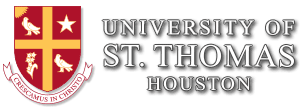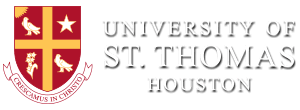Be Bold Blog
The University of St. Thomas (UST) is Houston’s Catholic University, committed to the Catholic intellectual tradition and the dialogue between faith and reason. Our blog is dedicated to helping you explore your future career possibilities and how to make the most of your college experience.
Med School Requirements
Texas Medical School Requirements Aspiring MDs Should Consider
It’s in your nature to help others whenever you can. This is a valuable trait given your desire to pursue a medical career — doctors are among the most service-minded professionals out there.
Because there are so many intelligent, hardworking students like you who are also interested in becoming physicians, the medical school applicant pool is quite competitive. But this is no surprise to you — you’re already thinking about what you can do to craft an application that stands out. While it can feel overwhelming at first, learning the ins and outs of Texas medical school requirements can help.
Dr. Gabriel Villares, assistant professor of biology at the University of St. Thomas (UST), has particular insight into the process of applying to medical school in Texas. Consider his advice as you start planning your path to medical school.

Texas medical school requirements: 10 components to complete
“The public medical schools in Texas have agreed to follow the same rules and guidelines,” Dr. Villares says, alluding to the Texas Medical and Dental Schools Application Service (TMDSAS). Most other medical schools, in comparison, use the American Medical College Application Service (AMCAS).
Students in Texas should familiarize themselves with the former by taking a look at the following requirements:
1. Complete all prerequisite courses
It’s essential that you verify required coursework for each school since they can vary. That said, you’ll cover most of your bases by following the TMDSAS-recommended number of credit hours in seven concentrations. You’ll want to put your best foot forward when it comes to these classes.
“TMDSAS says that you need to have a C or better in any of those classes for it to count as a prerequisite,” Dr. Villares notes, “but if you get Cs in those courses, you’re not going to get any interviews.”
It’s worth pointing out that the average overall GPA for students accepted to Texas medical schools in 2018 was 3.77. These same students had an average science GPA of 3.69.
2. Get involved in healthcare experiences
Getting used to working with patients through healthcare activities ensures that you truly understand what the field is like before committing your life to it. Participating in these experiences also helps medical schools understand your commitment. Physician shadowing is probably most common way to accumulate healthcare experience, but expect to take some initiative to find opportunities.
“You’re not going to get a response to an email you send to a doctor’s office about trying to shadow,” Dr. Villares warns. “You need to go to that office.”
Don’t forget to make use of your network when looking for places to shadow. Many students find that organizations like the Tri Beta National Biological Honor Society are great for finding out about opportunities.
3. Participate in plenty of extracurricular activities
Medically related experiences are important, but medical schools also dig into the other activities you’ve participated in during college like research or sports. Volunteer work is particularly important. And Dr. Villares adds that it’s a red flag to see that a student rushed through all their volunteering in a short period of time, suggesting they may have simply been trying to check it off their list.
“That’s not the point,” he elaborates. “The point is that you are volunteering throughout your time as an undergraduate student to show that you’re committed to helping humanity and society.”
4. Take the MCAT
Programs also look closely at how well you perform on the Medical College Admission Test (MCAT) as a way to evaluate your ability to think critically and your knowledge of different sciences. Students who started their studies at a Texas medical school in 2018 achieved an average MCAT score of 510.
Aside from doing well in your prerequisite courses, you’ll also want to set aside some dedicated MCAT review time. Some students find it helpful to take prep courses. And every pre-med student can benefit from taking practice exams. UST, for instance, offers a mock test that aims to simulate the experience as accurately as possible by following the same guidelines the MCAT does.
“They get used to that tension,” Dr. Villares explains. “We don’t want students to go in there without actually knowing about all the little extras they’re going to have to go through.”
5. Secure solid letters of evaluation
TMDSAS is quite different from AMCAS when it comes to letters of recommendation. You’re limited to either one health professions committee packet, which is composed by multiple faculty members at your college, or three individual letters of evaluation. Securing a committee packet is the best option, because it summarizes everything admissions committees care about.
“If you choose to not go through a committee and your school offers it, a lot of medical schools will see that as a red flag,” Dr. Villares says. “They’ll want to know, ‘What is this student hiding that they don’t want the committee to find out about?’”
It’s also important to point out that not every school has a health professions committee. Students at those schools won’t be penalized for submitting three individual letters. And it’s also possible to submit one additional letter from an individual, but that’s the maximum TMDSAS allows.
6. Write standout essays
Every medical student writes a personal statement — an essay that explains why you want to become a physician — when applying to medical school. But students applying to programs through TMDSAS actually go even further. All Texas medical school applicants complete at least two, and possibly three, essays for their applications.
The second required essay allows you to give medical schools a fuller picture of who you are by explaining how your characteristics or background can positively contribute to other students’ educational experiences. The third essay isn’t required, but most advisors consider it essential. It’s a space to discuss previously unmentioned experiences that could be relevant to your application.
“It’s not really optional,” Dr. Villares asserts.
7. Fill out and submit your applications
There’s a lot of information you’ll need to fill out for your TMDSAS application — personal information, your educational history and much more. You’ll also need to pay a flat $185 application fee. While you aren’t required to apply to each school that uses TMDSAS, it’s in your best interest to do so. Applying broadly gives you the best chance of securing a seat in such a competitive landscape. It’s also wise to submit your applications early.
The earlier you apply, the better your chances of getting an interview,” Dr. Villares says. “We really want our students to apply in May and June.” TMDSAS data actually shows candidates who submit their applications in spring and early summer are much more likely to receive interview offers.
8. Send in all supporting documents
Your job isn’t done after you’ve completed your applications. Texas medical schools also require candidates to submit official letters of evaluation, transcripts and MCAT scores. Also know that most schools require you to complete secondary applications, supplemental essays that are more specific to the institution.
“As soon as you get that secondary application, you need to fill it out and submit it,” Dr. Villares emphasizes.
A few schools also require you to take a situational judgement test called CASPer to assess what you would do in a variety of scenarios. It’s a relatively new requirement, but it could prove useful for schools in the future.
9. Attend medical school interviews
Medical schools only interview candidates who they’re seriously considering for their program. You deserve a huge congratulations if you get invited for one or more interviews. That said, preparation is essential.
While responding with answers you’ve memorized isn’t a good idea, you do want to practice. Talking through likely questions is often a huge help. If you’re lucky enough to attend a school that offers mock interview services, take advantage. UST students are especially lucky in that they can participate in a series of three mock interviews conducted by physician alumni who provide immediate feedback afterward.
10. Rank schools during the match process
The final step on your journey toward attending a Texas medical school is ranking programs where you attended interviews. Medical schools do the same. That information is used to match students into programs. It’s effectively the same process the National Resident Matching Program (NRMP) uses to place medical students into postgraduate training positions.
The key difference between the NRMP and TMDSAS processes is that Texas medical schools can extend pre-match offers to students before the match takes place. Students can, but don’t have to, accept one of these offers.
“Let’s say that you were interviewed at five schools and got two pre-match offers, but you ranked one of the schools that didn’t give you an offer as number one,” Dr. Villares offers. “You could actually match to that school.”
Lay the foundation for your future as a physician
Becoming a doctor doesn’t happen quickly. But the path to your intended career is a lot less daunting when you consider the various Texas medical school requirements one at a time. It also helps to attend a college that provides guidance for you every step of the way.
If you know you’re meant to pursue a career in medicine, you might want to start thinking about how you can build the educational foundation you’ll need. You can even choose a non-science major if you attend the right school. Find out how to receive an education that can prepare your for medical school by visiting the UST Pre-Medical Track page.
Ready to take the next step?
Related articles
About UST
The University of St. Thomas (UST) is Houston’s Catholic University, committed to the religious, ethical and intellectual traditions of Catholic higher education. For more than 70 years, we’ve been graduating students like you into successful careers in medicine, education, business, public administration and more – throughout Houston and across the globe.

